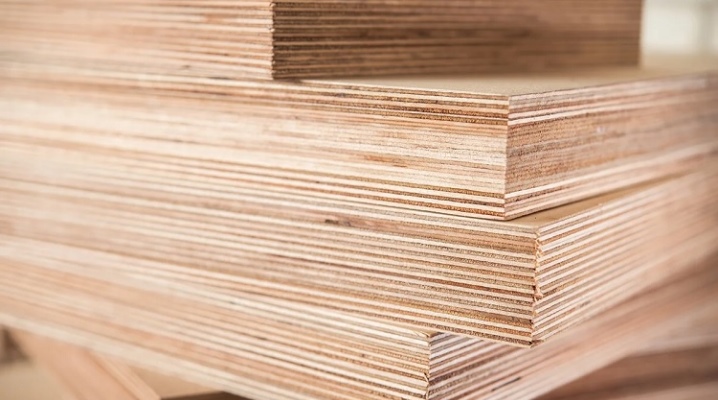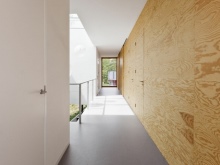Overview of types and grades of plywood

For repair and construction work, a large amount of materials and tools are required. At the same time, it is very important that the products used are distinguished by their durability, reliability and budgetary price. One of the most common materials is plywood. However, not every person knows that there are a large number of different types of it. In our article we will talk about what varieties of such material exist and how to choose the right option for you.



Varieties
Generally speaking, plywood is a material that consists of several layers of wood (there should be at least 3 of them). Moreover, each new layer should be located in a perpendicular position with respect to the previous one. Thanks to this manufacturing technique, strength and density are significantly increased. To combine all layers together, a special adhesive is traditionally used, which also increases the level of resistance to unwanted moisture.
Today there are several types of plywood, which differ from each other in their internal and external characteristics, as well as functional purpose.
The properties of each variety are detailed in various official documents and must comply with GOST.



Let's take a closer look at the assortment of plywood, and also take a closer look at the designation, brands, classes and descriptions of materials.
- E. This variety is considered the highest (or extra) and has a high level of quality. This is primarily due to the fact that the material does not contain any extraneous additives that could negatively affect the plywood. Most often, type E plywood is used for the so-called finishing. In addition, it is important to note the fact that this material has a high cost (compared to other varieties).
- 1. The main difference between the first grade is the possibility of a small number of defects and irregularities. So, in this type of material there are knots, a slight uneven color is also acceptable. Grade 1 can be used for both exterior and interior decoration.
- 2. This type of plywood allows for more serious disadvantages. For example, there may be cracks on the material (however, their length should not exceed 20 cm). In addition, there may be repair inserts with which knots or cavities were sealed. Glue may also leak.
- 3... This variety is often designated with the letters BBC. Plywood can have a variety of disadvantages. For example, the presence of cracks, knots, etc. is allowed. Usually, all these imperfections can be hidden with the help of specially designed paints and varnishes.
- 4... Among all the varieties that have been described above, this one has the lowest quality. So, plywood can have such defects as wormholes, non-intergrown knots falling out, uneven edges, etc. Accordingly, it can be concluded that such material is suitable only for the initial finish.
Thus, we can conclude that the division of plywood into grades means the level of purity and quality of the wood.



Materials (edit)
As mentioned above, plywood is made from wood. However, a wide variety of wood types can be used as raw materials. Let's take a look at some of them.
- Birch... Birch plywood is most commonly used in the construction industry.This is due to the fact that this material has such important characteristics as strength and density (650 kilograms per cubic meter). In addition, birch plywood is very uniform in structure. It should be borne in mind that birch material is quite expensive.
- Needles... For the production of coniferous plywood, spruce and pine are most often used. It should be borne in mind that the needles are inferior in strength to birch, but at the same time they have less weight. The composition of coniferous wood includes various resins, thanks to which the natural protection of the material from decay processes occurs. Coniferous wood is often used for decoration and decoration.
- Combined type. In this case, a wide variety of wood types (for example, coniferous and deciduous) can be used during the manufacture. Such material can be used in various fields.


Impregnation types
Depending on the composition of the glue that is used to impregnate and join all the layers of plywood together, experts distinguish several categories of wood material.
- FC... Plywood with urea adhesive guarantees a low level of resistance to moisture. The material is safe for people, it does not contain harmful additives. Therefore, it can be used even in children's rooms.
- FSF... This abbreviation denotes a composition such as phenol-formaldehyde glue. It provides the highest possible level of moisture resistance. At the same time, it should be borne in mind that the glue contains a large number of various harmful resins that can have a negative effect on human health. Accordingly, it is not recommended to use this plywood for residential premises, as well as in the production of furniture and any other items with which a person comes into direct contact.
- FBA... If plywood is treated with albuminocasein glue, then it is not resistant to water. The FBA material is environmentally friendly.
- FB... In the process of making such a material, a special bakelite glue is used. Thanks to this composition, plywood becomes resistant to unfavorable environmental conditions (for example, temperature drops or high humidity indicators).
- BS... This type of plywood belongs to the category of aviation materials. It is lightweight and has a large number of layers. Plywood is used in a wide variety of areas of human life, for example: for the manufacture of furniture, boats and various decorations.
- BV... The impregnation for this material is a water-soluble bakelite glue. Accordingly, this plywood cannot be used in rooms with high humidity or outdoors.
- FOF... This type of plywood belongs to the category of laminated materials, is considered facing, and is also characterized by increased moisture resistance.



Processing classification
During the manufacture of plywood, various methods of material processing can be applied. Let's consider them in more detail.
- NSh... The surface of such plywood does not undergo additional processing. Accordingly, the external structure is rather coarse, and therefore there is a high risk of unwanted cracks. This material is not suitable for fine finishing.
- Ш1... Processing is carried out only on one side (hence the name). Moreover, the risk of cracking is quite small.
- W2... Plywood Ш2 undergoes the most careful and long-term processing. As a result, the ability to absorb moisture is minimal.
Thanks to this, the material Ш can be used to create decorative items.



By type of environmental safety
During the manufacture of plywood, a harmful substance such as formaldehyde is used. In this regard, specialists have developed a special scale for the environmental friendliness of the material (it is based on the level of formaldehyde emission).
- E1... If the plywood you purchase is marked with the E1 designation, then you should bear in mind the fact that the material will emit 10 mg of harmful substance per 100 g of dry wood. These indicators make it possible to use the material even in residential conditions.
- E2... Such plywood emits a large amount of harmful substances, therefore, it is not recommended for use in residential premises or for the manufacture of furniture.


Varieties by purpose
Plywood is a popular construction material that is used in a wide variety of areas of human life.
- For furniture... For the manufacture of furniture, a special type of plywood is used, which is distinguished by such important characteristics as environmental friendliness and resistance to the influence of environmental factors.
- Construction... The material is used for both finishing and rough finishing. Moreover, in the second case, the material is most often used, the raw material for the manufacture of which is birch.
- Formwork plywood. Some types of plywood (which exhibit increased resistance values) are used for formwork.
- Decorations and decoration... It is very important that the plywood used for finishing is of the highest possible quality. So, the material should have a perfectly flat and smooth surface.
- Automotive... Plywood can serve as a cladding material for body elements of trucks. In this case, laminated or mesh-ribbed material is often used.
- Korabelnaya... For the shipbuilding industry, plywood sheets are required that differ in moisture resistance.
Accordingly, we can conclude that plywood is a material that professionals of a wide profile cannot do without.



How to choose?
The plywood selection process is a demanding task. It is very important to approach it with great care, as well as taking into account several key factors. So, first of all, in order to determine which type of wood is best suited for your purposes, you should carefully study the plywood labeling and its decoding. These indicators regulate the quality of the material, respectively, and the area of its use. In the process of choosing and buying material, pay close attention to the availability of documents, ask the seller to demonstrate all the quality certificates he has.
If you plan to use the material as a finishing or decorative material, then you need to carefully select the color, pattern and size. remember, that plywood should fit well with the style of your room. Thus, it can be concluded that plywood is a very important wood material that is used for a variety of tasks.
However, before purchasing the material, it is important to familiarize yourself with the existing varieties and species in order to choose the one that will fully meet your needs and requirements.



For information on which plywood is better, see the next video.













The comment was sent successfully.